University Leadership and Culture in Organizational Contexts Report
VerifiedAdded on 2021/04/21
|20
|4472
|217
Report
AI Summary
This report provides a comprehensive overview of leadership and culture within an organizational context. It begins by defining and exploring the concepts of character and personality, emphasizing the importance of character in leadership and discussing different character types. The report then delves into ethical values and beliefs, examining their influence on leadership and how they can change in various situations. It contextualizes a range of leadership theories, including the Great Man Theory, Trait Theory, and emotional leadership styles, while also addressing the challenges faced by leaders whose values differ from their leadership styles. Practical examples such as Nelson Mandela, British Petroleum, and the President's Club are analyzed. Finally, the report explores the role and impact of philosophical paradigms on leadership, contrasting traditional and modern styles, discussing the 'born versus made' debate, and highlighting the challenges encountered by young leaders. This report offers valuable insights into the multifaceted nature of leadership and its relationship with organizational culture.
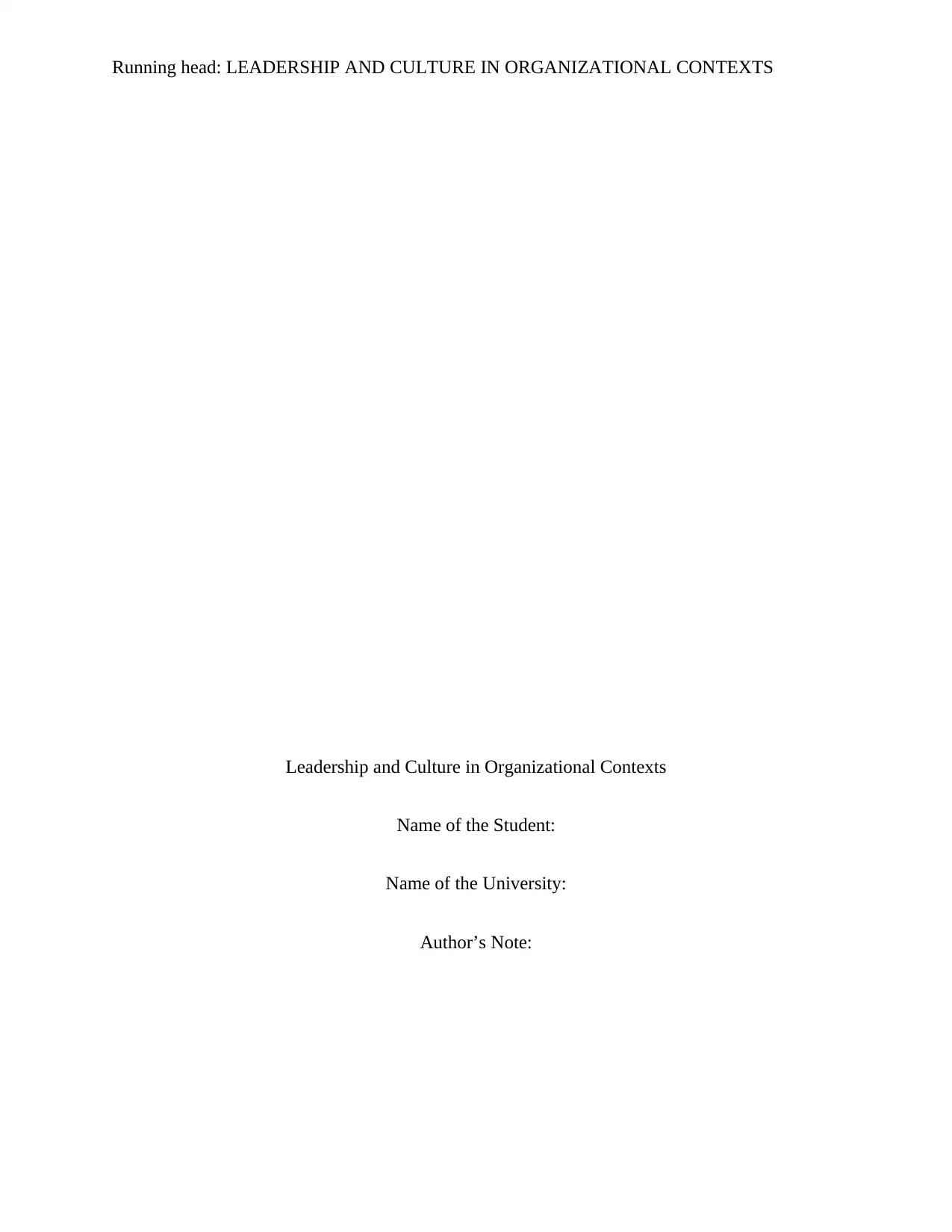
Running head: LEADERSHIP AND CULTURE IN ORGANIZATIONAL CONTEXTS
Leadership and Culture in Organizational Contexts
Name of the Student:
Name of the University:
Author’s Note:
Leadership and Culture in Organizational Contexts
Name of the Student:
Name of the University:
Author’s Note:
Paraphrase This Document
Need a fresh take? Get an instant paraphrase of this document with our AI Paraphraser
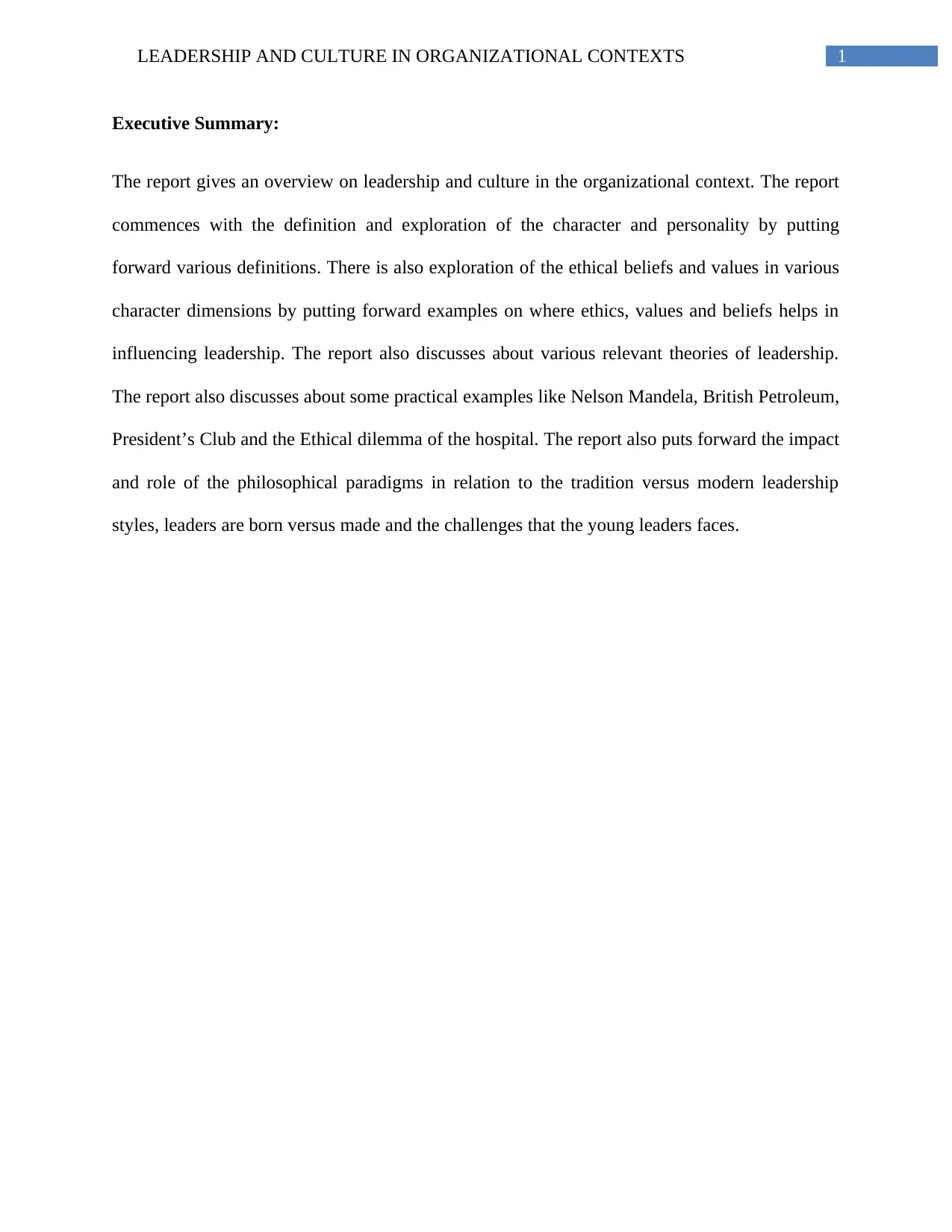
1LEADERSHIP AND CULTURE IN ORGANIZATIONAL CONTEXTS
Executive Summary:
The report gives an overview on leadership and culture in the organizational context. The report
commences with the definition and exploration of the character and personality by putting
forward various definitions. There is also exploration of the ethical beliefs and values in various
character dimensions by putting forward examples on where ethics, values and beliefs helps in
influencing leadership. The report also discusses about various relevant theories of leadership.
The report also discusses about some practical examples like Nelson Mandela, British Petroleum,
President’s Club and the Ethical dilemma of the hospital. The report also puts forward the impact
and role of the philosophical paradigms in relation to the tradition versus modern leadership
styles, leaders are born versus made and the challenges that the young leaders faces.
Executive Summary:
The report gives an overview on leadership and culture in the organizational context. The report
commences with the definition and exploration of the character and personality by putting
forward various definitions. There is also exploration of the ethical beliefs and values in various
character dimensions by putting forward examples on where ethics, values and beliefs helps in
influencing leadership. The report also discusses about various relevant theories of leadership.
The report also discusses about some practical examples like Nelson Mandela, British Petroleum,
President’s Club and the Ethical dilemma of the hospital. The report also puts forward the impact
and role of the philosophical paradigms in relation to the tradition versus modern leadership
styles, leaders are born versus made and the challenges that the young leaders faces.
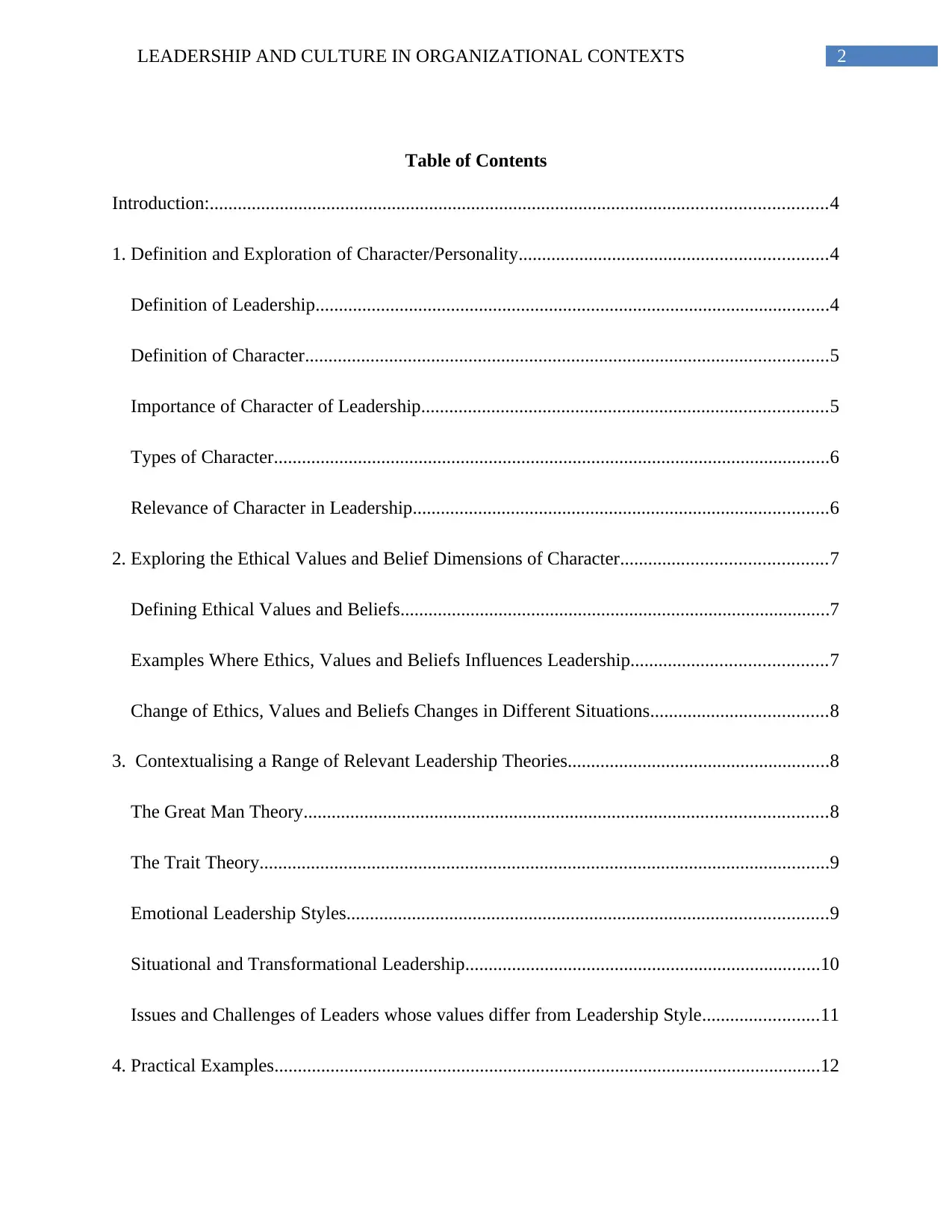
2LEADERSHIP AND CULTURE IN ORGANIZATIONAL CONTEXTS
Table of Contents
Introduction:....................................................................................................................................4
1. Definition and Exploration of Character/Personality..................................................................4
Definition of Leadership..............................................................................................................4
Definition of Character................................................................................................................5
Importance of Character of Leadership.......................................................................................5
Types of Character.......................................................................................................................6
Relevance of Character in Leadership.........................................................................................6
2. Exploring the Ethical Values and Belief Dimensions of Character............................................7
Defining Ethical Values and Beliefs............................................................................................7
Examples Where Ethics, Values and Beliefs Influences Leadership..........................................7
Change of Ethics, Values and Beliefs Changes in Different Situations......................................8
3. Contextualising a Range of Relevant Leadership Theories........................................................8
The Great Man Theory................................................................................................................8
The Trait Theory..........................................................................................................................9
Emotional Leadership Styles.......................................................................................................9
Situational and Transformational Leadership............................................................................10
Issues and Challenges of Leaders whose values differ from Leadership Style.........................11
4. Practical Examples.....................................................................................................................12
Table of Contents
Introduction:....................................................................................................................................4
1. Definition and Exploration of Character/Personality..................................................................4
Definition of Leadership..............................................................................................................4
Definition of Character................................................................................................................5
Importance of Character of Leadership.......................................................................................5
Types of Character.......................................................................................................................6
Relevance of Character in Leadership.........................................................................................6
2. Exploring the Ethical Values and Belief Dimensions of Character............................................7
Defining Ethical Values and Beliefs............................................................................................7
Examples Where Ethics, Values and Beliefs Influences Leadership..........................................7
Change of Ethics, Values and Beliefs Changes in Different Situations......................................8
3. Contextualising a Range of Relevant Leadership Theories........................................................8
The Great Man Theory................................................................................................................8
The Trait Theory..........................................................................................................................9
Emotional Leadership Styles.......................................................................................................9
Situational and Transformational Leadership............................................................................10
Issues and Challenges of Leaders whose values differ from Leadership Style.........................11
4. Practical Examples.....................................................................................................................12
⊘ This is a preview!⊘
Do you want full access?
Subscribe today to unlock all pages.

Trusted by 1+ million students worldwide
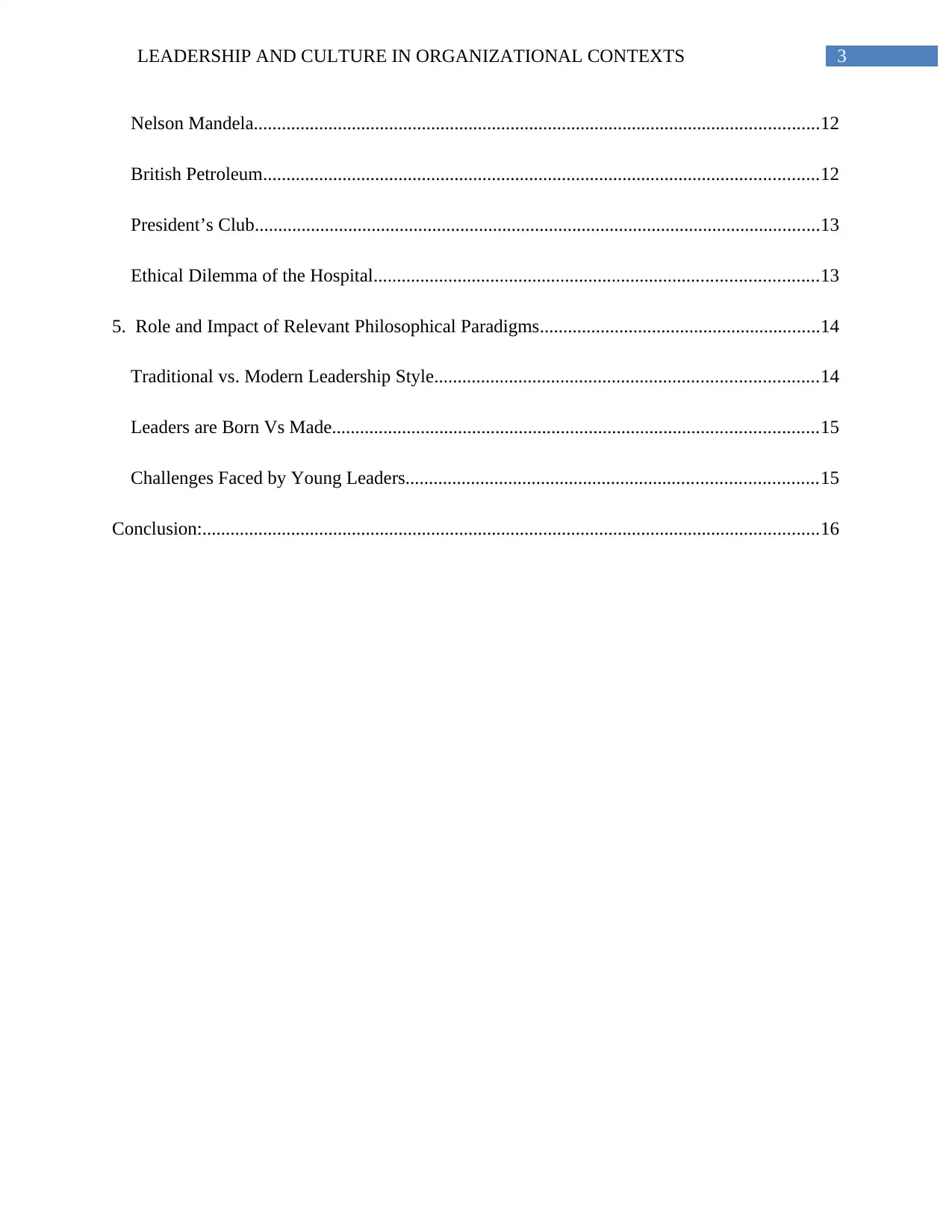
3LEADERSHIP AND CULTURE IN ORGANIZATIONAL CONTEXTS
Nelson Mandela.........................................................................................................................12
British Petroleum.......................................................................................................................12
President’s Club.........................................................................................................................13
Ethical Dilemma of the Hospital...............................................................................................13
5. Role and Impact of Relevant Philosophical Paradigms............................................................14
Traditional vs. Modern Leadership Style..................................................................................14
Leaders are Born Vs Made........................................................................................................15
Challenges Faced by Young Leaders........................................................................................15
Conclusion:....................................................................................................................................16
Nelson Mandela.........................................................................................................................12
British Petroleum.......................................................................................................................12
President’s Club.........................................................................................................................13
Ethical Dilemma of the Hospital...............................................................................................13
5. Role and Impact of Relevant Philosophical Paradigms............................................................14
Traditional vs. Modern Leadership Style..................................................................................14
Leaders are Born Vs Made........................................................................................................15
Challenges Faced by Young Leaders........................................................................................15
Conclusion:....................................................................................................................................16
Paraphrase This Document
Need a fresh take? Get an instant paraphrase of this document with our AI Paraphraser
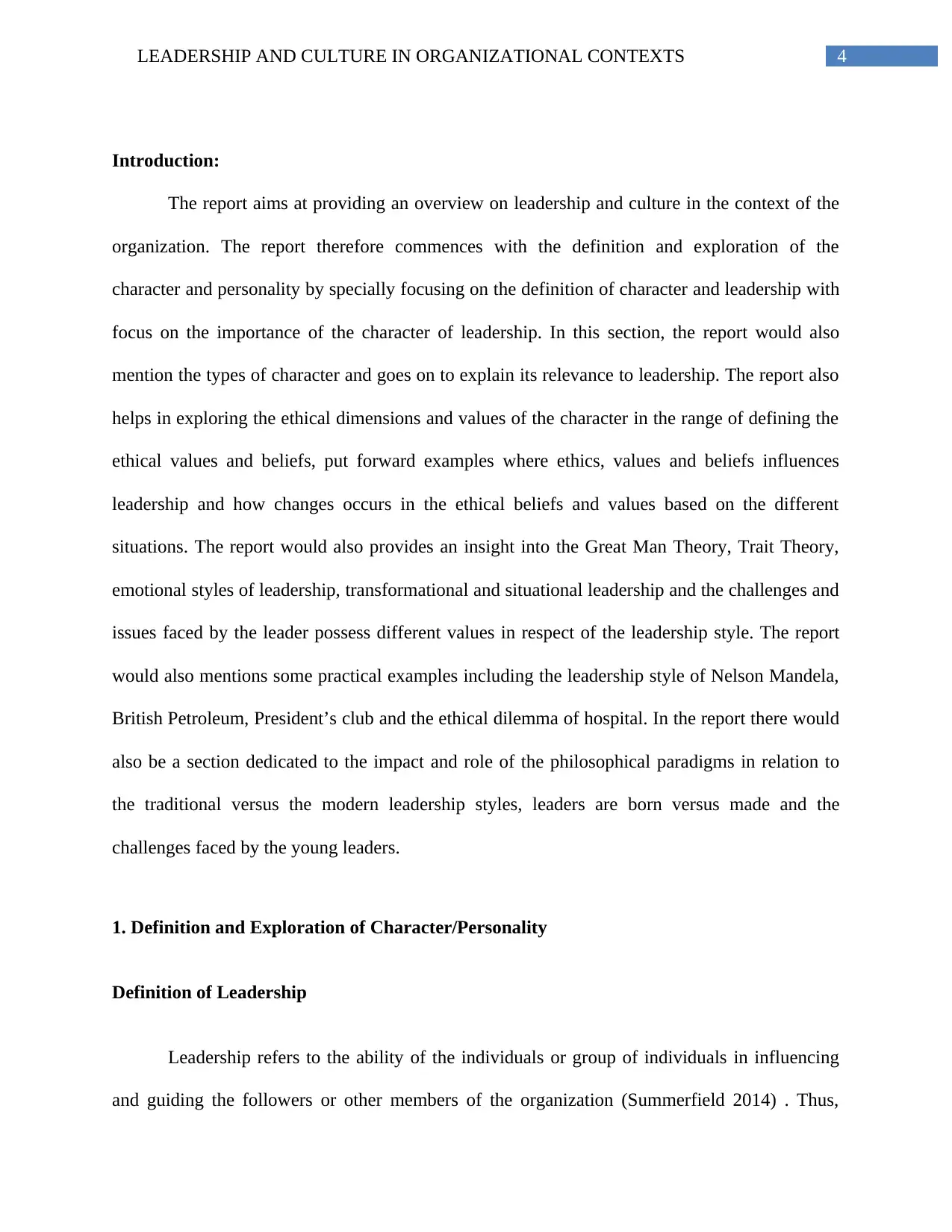
4LEADERSHIP AND CULTURE IN ORGANIZATIONAL CONTEXTS
Introduction:
The report aims at providing an overview on leadership and culture in the context of the
organization. The report therefore commences with the definition and exploration of the
character and personality by specially focusing on the definition of character and leadership with
focus on the importance of the character of leadership. In this section, the report would also
mention the types of character and goes on to explain its relevance to leadership. The report also
helps in exploring the ethical dimensions and values of the character in the range of defining the
ethical values and beliefs, put forward examples where ethics, values and beliefs influences
leadership and how changes occurs in the ethical beliefs and values based on the different
situations. The report would also provides an insight into the Great Man Theory, Trait Theory,
emotional styles of leadership, transformational and situational leadership and the challenges and
issues faced by the leader possess different values in respect of the leadership style. The report
would also mentions some practical examples including the leadership style of Nelson Mandela,
British Petroleum, President’s club and the ethical dilemma of hospital. In the report there would
also be a section dedicated to the impact and role of the philosophical paradigms in relation to
the traditional versus the modern leadership styles, leaders are born versus made and the
challenges faced by the young leaders.
1. Definition and Exploration of Character/Personality
Definition of Leadership
Leadership refers to the ability of the individuals or group of individuals in influencing
and guiding the followers or other members of the organization (Summerfield 2014) . Thus,
Introduction:
The report aims at providing an overview on leadership and culture in the context of the
organization. The report therefore commences with the definition and exploration of the
character and personality by specially focusing on the definition of character and leadership with
focus on the importance of the character of leadership. In this section, the report would also
mention the types of character and goes on to explain its relevance to leadership. The report also
helps in exploring the ethical dimensions and values of the character in the range of defining the
ethical values and beliefs, put forward examples where ethics, values and beliefs influences
leadership and how changes occurs in the ethical beliefs and values based on the different
situations. The report would also provides an insight into the Great Man Theory, Trait Theory,
emotional styles of leadership, transformational and situational leadership and the challenges and
issues faced by the leader possess different values in respect of the leadership style. The report
would also mentions some practical examples including the leadership style of Nelson Mandela,
British Petroleum, President’s club and the ethical dilemma of hospital. In the report there would
also be a section dedicated to the impact and role of the philosophical paradigms in relation to
the traditional versus the modern leadership styles, leaders are born versus made and the
challenges faced by the young leaders.
1. Definition and Exploration of Character/Personality
Definition of Leadership
Leadership refers to the ability of the individuals or group of individuals in influencing
and guiding the followers or other members of the organization (Summerfield 2014) . Thus,
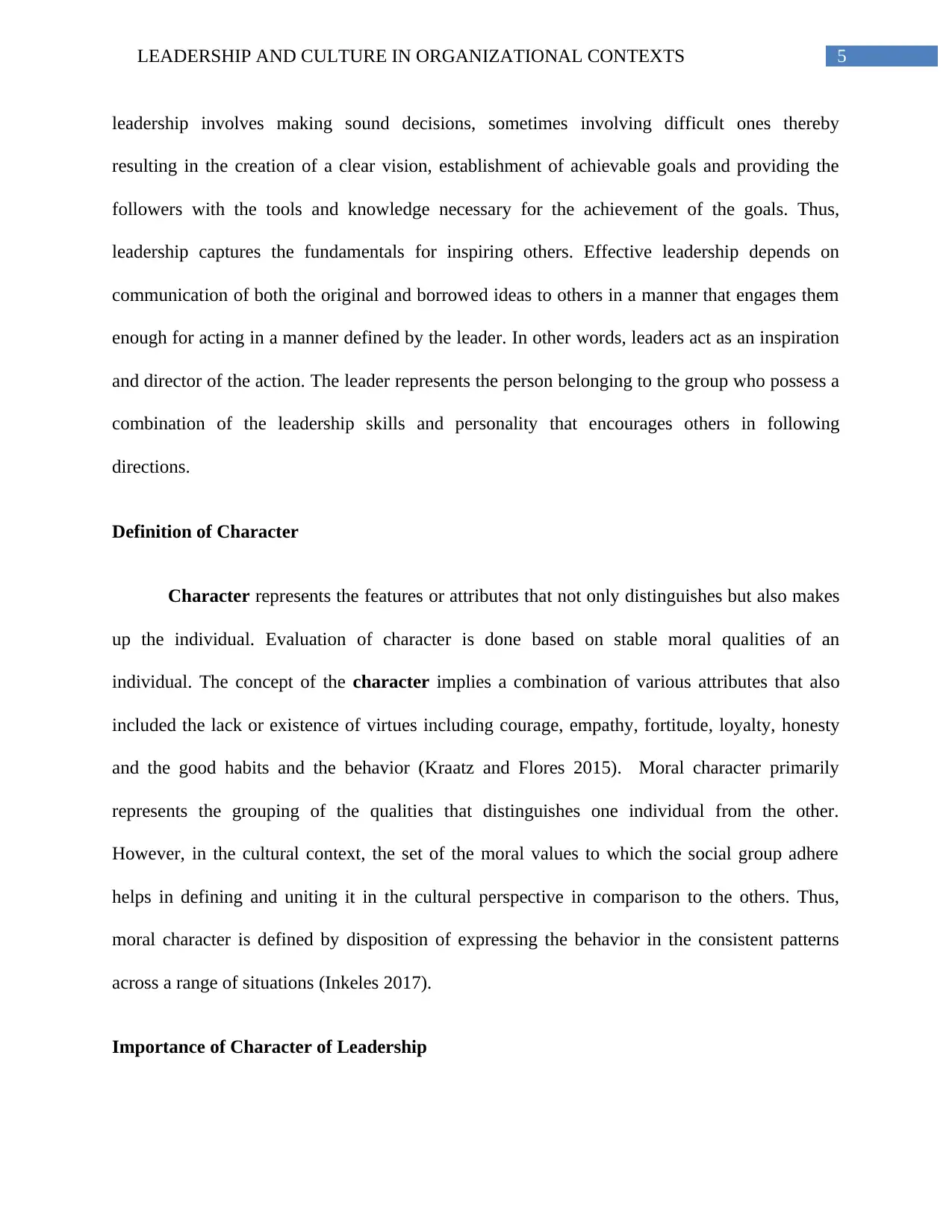
5LEADERSHIP AND CULTURE IN ORGANIZATIONAL CONTEXTS
leadership involves making sound decisions, sometimes involving difficult ones thereby
resulting in the creation of a clear vision, establishment of achievable goals and providing the
followers with the tools and knowledge necessary for the achievement of the goals. Thus,
leadership captures the fundamentals for inspiring others. Effective leadership depends on
communication of both the original and borrowed ideas to others in a manner that engages them
enough for acting in a manner defined by the leader. In other words, leaders act as an inspiration
and director of the action. The leader represents the person belonging to the group who possess a
combination of the leadership skills and personality that encourages others in following
directions.
Definition of Character
Character represents the features or attributes that not only distinguishes but also makes
up the individual. Evaluation of character is done based on stable moral qualities of an
individual. The concept of the character implies a combination of various attributes that also
included the lack or existence of virtues including courage, empathy, fortitude, loyalty, honesty
and the good habits and the behavior (Kraatz and Flores 2015). Moral character primarily
represents the grouping of the qualities that distinguishes one individual from the other.
However, in the cultural context, the set of the moral values to which the social group adhere
helps in defining and uniting it in the cultural perspective in comparison to the others. Thus,
moral character is defined by disposition of expressing the behavior in the consistent patterns
across a range of situations (Inkeles 2017).
Importance of Character of Leadership
leadership involves making sound decisions, sometimes involving difficult ones thereby
resulting in the creation of a clear vision, establishment of achievable goals and providing the
followers with the tools and knowledge necessary for the achievement of the goals. Thus,
leadership captures the fundamentals for inspiring others. Effective leadership depends on
communication of both the original and borrowed ideas to others in a manner that engages them
enough for acting in a manner defined by the leader. In other words, leaders act as an inspiration
and director of the action. The leader represents the person belonging to the group who possess a
combination of the leadership skills and personality that encourages others in following
directions.
Definition of Character
Character represents the features or attributes that not only distinguishes but also makes
up the individual. Evaluation of character is done based on stable moral qualities of an
individual. The concept of the character implies a combination of various attributes that also
included the lack or existence of virtues including courage, empathy, fortitude, loyalty, honesty
and the good habits and the behavior (Kraatz and Flores 2015). Moral character primarily
represents the grouping of the qualities that distinguishes one individual from the other.
However, in the cultural context, the set of the moral values to which the social group adhere
helps in defining and uniting it in the cultural perspective in comparison to the others. Thus,
moral character is defined by disposition of expressing the behavior in the consistent patterns
across a range of situations (Inkeles 2017).
Importance of Character of Leadership
⊘ This is a preview!⊘
Do you want full access?
Subscribe today to unlock all pages.

Trusted by 1+ million students worldwide

6LEADERSHIP AND CULTURE IN ORGANIZATIONAL CONTEXTS
The notion of character holds utmost importance for an effective leader since it helps in
building trust without which people would not follow him or her (Alfano 2013). By gaining the
trust of the people, leaders can not only motivate them but also ensure accomplishing extra
ordinary things. Our character represents a mark into something that is enduring. Similar to
moulding mannerisms character needs a chiselling touch. The most enduring thing about an
individual represents the features and the traits that apparently form the nature of the individual.
A leader in possession of a good character has higher score for integrity, compassion,
responsibility and forgiveness (Cooper 2014). Thus, character represents an essential trait for
leadership.
Types of Character
A leader with character helps in achieving results that transcends everyday organizational
outcomes and imperatives. There are various types of characters possessed by a leader like
integrity, honesty, intelligence, courageous, fairness, straightforward and inspiring. Integrity
represents having stronger core values and moral principles with which the leader conducts his or
life along with guiding his followers (Bauman 2013). Honesty on the part of the leaders
represents telling the truth. Leaders should be intelligent enough in reading, studying and seeking
challenging assignments. They should also be courageous that is possess enough perseverance in
accomplishing the goals regardless of the persisting obstacles. Fair-minded leaders ensure fair
treatment to all the people. Leaders should be straightforward enough for making sound
judgment and taking good decisions. The mental, physical and the spiritual stamina possessed by
the leaders inspire others in reaching newer heights.
Relevance of Character in Leadership
The notion of character holds utmost importance for an effective leader since it helps in
building trust without which people would not follow him or her (Alfano 2013). By gaining the
trust of the people, leaders can not only motivate them but also ensure accomplishing extra
ordinary things. Our character represents a mark into something that is enduring. Similar to
moulding mannerisms character needs a chiselling touch. The most enduring thing about an
individual represents the features and the traits that apparently form the nature of the individual.
A leader in possession of a good character has higher score for integrity, compassion,
responsibility and forgiveness (Cooper 2014). Thus, character represents an essential trait for
leadership.
Types of Character
A leader with character helps in achieving results that transcends everyday organizational
outcomes and imperatives. There are various types of characters possessed by a leader like
integrity, honesty, intelligence, courageous, fairness, straightforward and inspiring. Integrity
represents having stronger core values and moral principles with which the leader conducts his or
life along with guiding his followers (Bauman 2013). Honesty on the part of the leaders
represents telling the truth. Leaders should be intelligent enough in reading, studying and seeking
challenging assignments. They should also be courageous that is possess enough perseverance in
accomplishing the goals regardless of the persisting obstacles. Fair-minded leaders ensure fair
treatment to all the people. Leaders should be straightforward enough for making sound
judgment and taking good decisions. The mental, physical and the spiritual stamina possessed by
the leaders inspire others in reaching newer heights.
Relevance of Character in Leadership
Paraphrase This Document
Need a fresh take? Get an instant paraphrase of this document with our AI Paraphraser
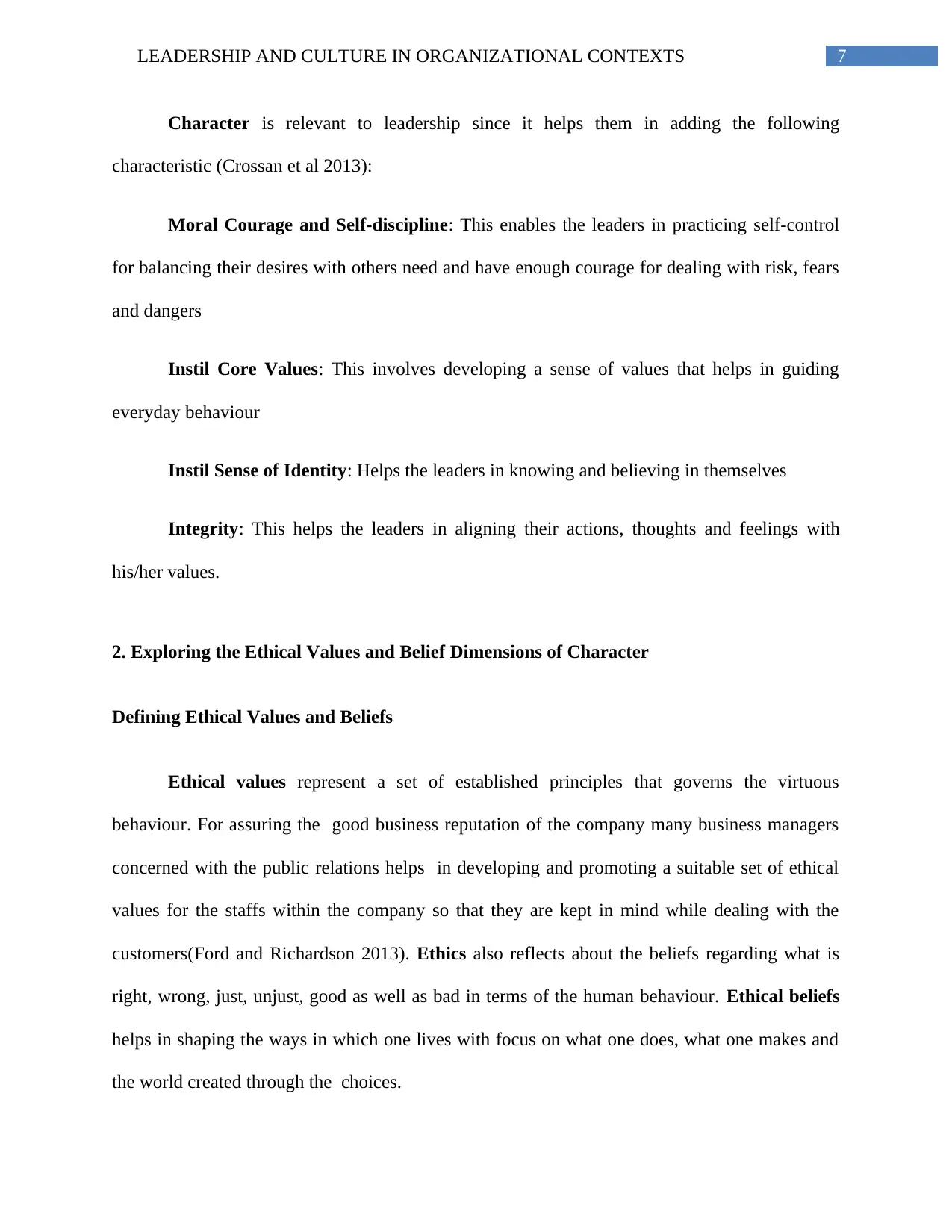
7LEADERSHIP AND CULTURE IN ORGANIZATIONAL CONTEXTS
Character is relevant to leadership since it helps them in adding the following
characteristic (Crossan et al 2013):
Moral Courage and Self-discipline: This enables the leaders in practicing self-control
for balancing their desires with others need and have enough courage for dealing with risk, fears
and dangers
Instil Core Values: This involves developing a sense of values that helps in guiding
everyday behaviour
Instil Sense of Identity: Helps the leaders in knowing and believing in themselves
Integrity: This helps the leaders in aligning their actions, thoughts and feelings with
his/her values.
2. Exploring the Ethical Values and Belief Dimensions of Character
Defining Ethical Values and Beliefs
Ethical values represent a set of established principles that governs the virtuous
behaviour. For assuring the good business reputation of the company many business managers
concerned with the public relations helps in developing and promoting a suitable set of ethical
values for the staffs within the company so that they are kept in mind while dealing with the
customers(Ford and Richardson 2013). Ethics also reflects about the beliefs regarding what is
right, wrong, just, unjust, good as well as bad in terms of the human behaviour. Ethical beliefs
helps in shaping the ways in which one lives with focus on what one does, what one makes and
the world created through the choices.
Character is relevant to leadership since it helps them in adding the following
characteristic (Crossan et al 2013):
Moral Courage and Self-discipline: This enables the leaders in practicing self-control
for balancing their desires with others need and have enough courage for dealing with risk, fears
and dangers
Instil Core Values: This involves developing a sense of values that helps in guiding
everyday behaviour
Instil Sense of Identity: Helps the leaders in knowing and believing in themselves
Integrity: This helps the leaders in aligning their actions, thoughts and feelings with
his/her values.
2. Exploring the Ethical Values and Belief Dimensions of Character
Defining Ethical Values and Beliefs
Ethical values represent a set of established principles that governs the virtuous
behaviour. For assuring the good business reputation of the company many business managers
concerned with the public relations helps in developing and promoting a suitable set of ethical
values for the staffs within the company so that they are kept in mind while dealing with the
customers(Ford and Richardson 2013). Ethics also reflects about the beliefs regarding what is
right, wrong, just, unjust, good as well as bad in terms of the human behaviour. Ethical beliefs
helps in shaping the ways in which one lives with focus on what one does, what one makes and
the world created through the choices.
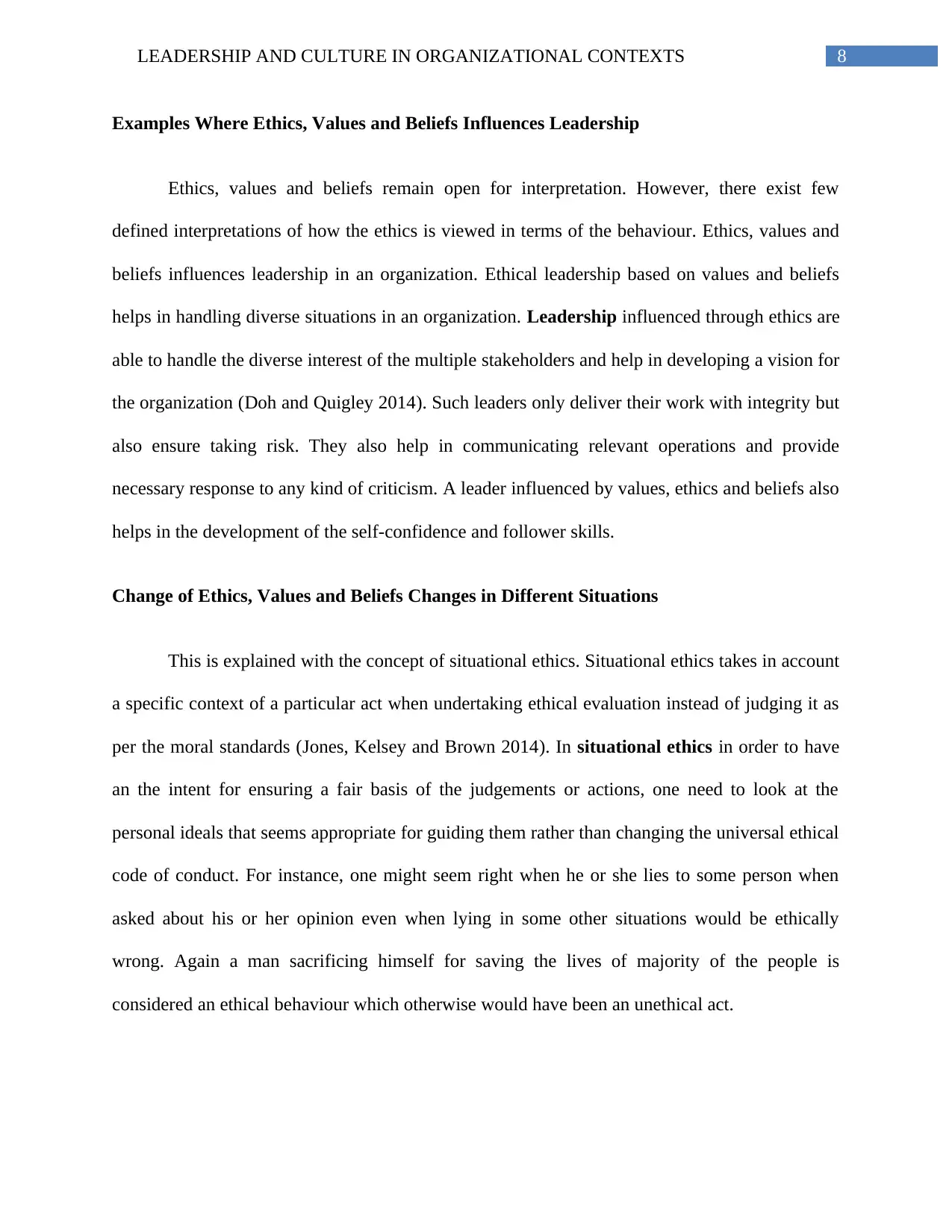
8LEADERSHIP AND CULTURE IN ORGANIZATIONAL CONTEXTS
Examples Where Ethics, Values and Beliefs Influences Leadership
Ethics, values and beliefs remain open for interpretation. However, there exist few
defined interpretations of how the ethics is viewed in terms of the behaviour. Ethics, values and
beliefs influences leadership in an organization. Ethical leadership based on values and beliefs
helps in handling diverse situations in an organization. Leadership influenced through ethics are
able to handle the diverse interest of the multiple stakeholders and help in developing a vision for
the organization (Doh and Quigley 2014). Such leaders only deliver their work with integrity but
also ensure taking risk. They also help in communicating relevant operations and provide
necessary response to any kind of criticism. A leader influenced by values, ethics and beliefs also
helps in the development of the self-confidence and follower skills.
Change of Ethics, Values and Beliefs Changes in Different Situations
This is explained with the concept of situational ethics. Situational ethics takes in account
a specific context of a particular act when undertaking ethical evaluation instead of judging it as
per the moral standards (Jones, Kelsey and Brown 2014). In situational ethics in order to have
an the intent for ensuring a fair basis of the judgements or actions, one need to look at the
personal ideals that seems appropriate for guiding them rather than changing the universal ethical
code of conduct. For instance, one might seem right when he or she lies to some person when
asked about his or her opinion even when lying in some other situations would be ethically
wrong. Again a man sacrificing himself for saving the lives of majority of the people is
considered an ethical behaviour which otherwise would have been an unethical act.
Examples Where Ethics, Values and Beliefs Influences Leadership
Ethics, values and beliefs remain open for interpretation. However, there exist few
defined interpretations of how the ethics is viewed in terms of the behaviour. Ethics, values and
beliefs influences leadership in an organization. Ethical leadership based on values and beliefs
helps in handling diverse situations in an organization. Leadership influenced through ethics are
able to handle the diverse interest of the multiple stakeholders and help in developing a vision for
the organization (Doh and Quigley 2014). Such leaders only deliver their work with integrity but
also ensure taking risk. They also help in communicating relevant operations and provide
necessary response to any kind of criticism. A leader influenced by values, ethics and beliefs also
helps in the development of the self-confidence and follower skills.
Change of Ethics, Values and Beliefs Changes in Different Situations
This is explained with the concept of situational ethics. Situational ethics takes in account
a specific context of a particular act when undertaking ethical evaluation instead of judging it as
per the moral standards (Jones, Kelsey and Brown 2014). In situational ethics in order to have
an the intent for ensuring a fair basis of the judgements or actions, one need to look at the
personal ideals that seems appropriate for guiding them rather than changing the universal ethical
code of conduct. For instance, one might seem right when he or she lies to some person when
asked about his or her opinion even when lying in some other situations would be ethically
wrong. Again a man sacrificing himself for saving the lives of majority of the people is
considered an ethical behaviour which otherwise would have been an unethical act.
⊘ This is a preview!⊘
Do you want full access?
Subscribe today to unlock all pages.

Trusted by 1+ million students worldwide
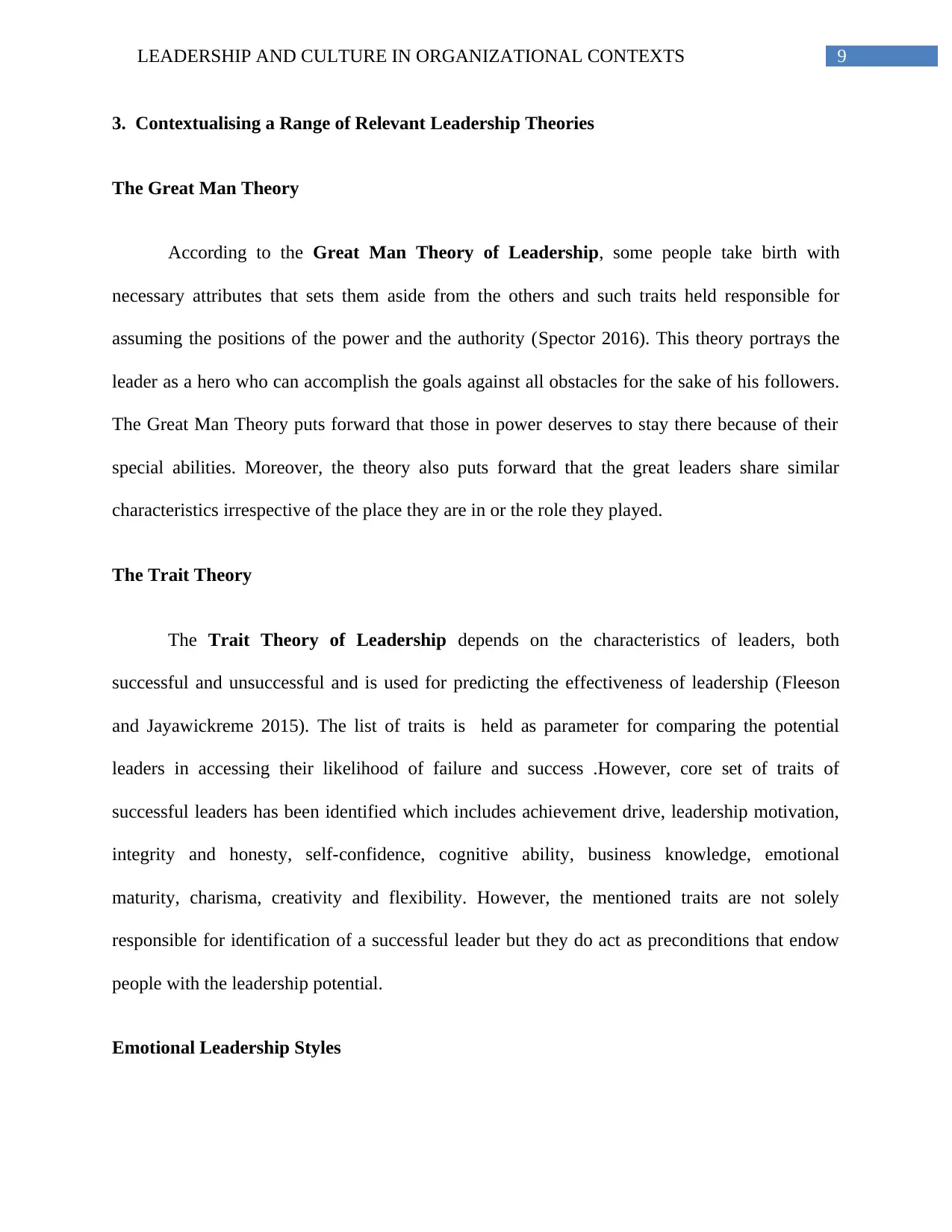
9LEADERSHIP AND CULTURE IN ORGANIZATIONAL CONTEXTS
3. Contextualising a Range of Relevant Leadership Theories
The Great Man Theory
According to the Great Man Theory of Leadership, some people take birth with
necessary attributes that sets them aside from the others and such traits held responsible for
assuming the positions of the power and the authority (Spector 2016). This theory portrays the
leader as a hero who can accomplish the goals against all obstacles for the sake of his followers.
The Great Man Theory puts forward that those in power deserves to stay there because of their
special abilities. Moreover, the theory also puts forward that the great leaders share similar
characteristics irrespective of the place they are in or the role they played.
The Trait Theory
The Trait Theory of Leadership depends on the characteristics of leaders, both
successful and unsuccessful and is used for predicting the effectiveness of leadership (Fleeson
and Jayawickreme 2015). The list of traits is held as parameter for comparing the potential
leaders in accessing their likelihood of failure and success .However, core set of traits of
successful leaders has been identified which includes achievement drive, leadership motivation,
integrity and honesty, self-confidence, cognitive ability, business knowledge, emotional
maturity, charisma, creativity and flexibility. However, the mentioned traits are not solely
responsible for identification of a successful leader but they do act as preconditions that endow
people with the leadership potential.
Emotional Leadership Styles
3. Contextualising a Range of Relevant Leadership Theories
The Great Man Theory
According to the Great Man Theory of Leadership, some people take birth with
necessary attributes that sets them aside from the others and such traits held responsible for
assuming the positions of the power and the authority (Spector 2016). This theory portrays the
leader as a hero who can accomplish the goals against all obstacles for the sake of his followers.
The Great Man Theory puts forward that those in power deserves to stay there because of their
special abilities. Moreover, the theory also puts forward that the great leaders share similar
characteristics irrespective of the place they are in or the role they played.
The Trait Theory
The Trait Theory of Leadership depends on the characteristics of leaders, both
successful and unsuccessful and is used for predicting the effectiveness of leadership (Fleeson
and Jayawickreme 2015). The list of traits is held as parameter for comparing the potential
leaders in accessing their likelihood of failure and success .However, core set of traits of
successful leaders has been identified which includes achievement drive, leadership motivation,
integrity and honesty, self-confidence, cognitive ability, business knowledge, emotional
maturity, charisma, creativity and flexibility. However, the mentioned traits are not solely
responsible for identification of a successful leader but they do act as preconditions that endow
people with the leadership potential.
Emotional Leadership Styles
Paraphrase This Document
Need a fresh take? Get an instant paraphrase of this document with our AI Paraphraser
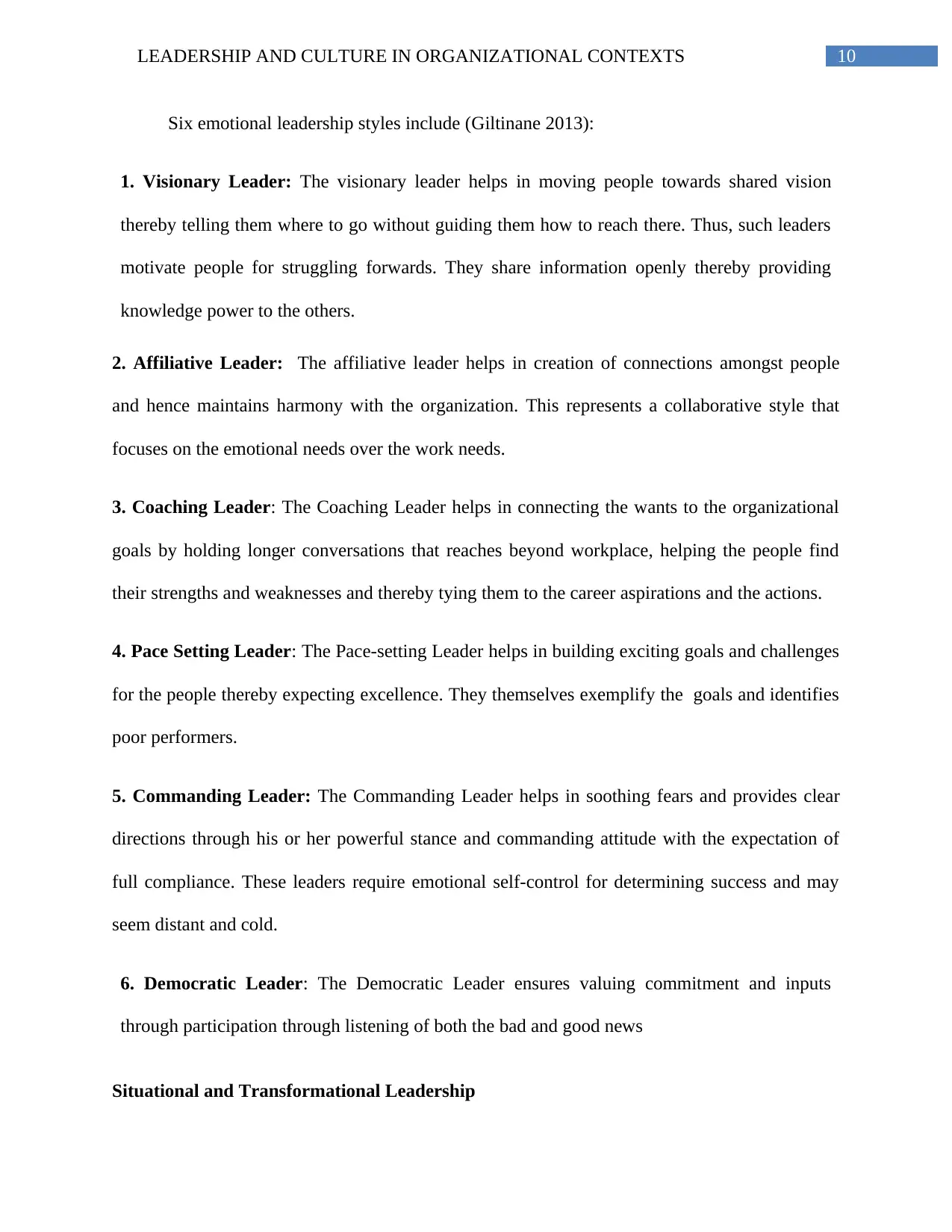
10LEADERSHIP AND CULTURE IN ORGANIZATIONAL CONTEXTS
Six emotional leadership styles include (Giltinane 2013):
1. Visionary Leader: The visionary leader helps in moving people towards shared vision
thereby telling them where to go without guiding them how to reach there. Thus, such leaders
motivate people for struggling forwards. They share information openly thereby providing
knowledge power to the others.
2. Affiliative Leader: The affiliative leader helps in creation of connections amongst people
and hence maintains harmony with the organization. This represents a collaborative style that
focuses on the emotional needs over the work needs.
3. Coaching Leader: The Coaching Leader helps in connecting the wants to the organizational
goals by holding longer conversations that reaches beyond workplace, helping the people find
their strengths and weaknesses and thereby tying them to the career aspirations and the actions.
4. Pace Setting Leader: The Pace-setting Leader helps in building exciting goals and challenges
for the people thereby expecting excellence. They themselves exemplify the goals and identifies
poor performers.
5. Commanding Leader: The Commanding Leader helps in soothing fears and provides clear
directions through his or her powerful stance and commanding attitude with the expectation of
full compliance. These leaders require emotional self-control for determining success and may
seem distant and cold.
6. Democratic Leader: The Democratic Leader ensures valuing commitment and inputs
through participation through listening of both the bad and good news
Situational and Transformational Leadership
Six emotional leadership styles include (Giltinane 2013):
1. Visionary Leader: The visionary leader helps in moving people towards shared vision
thereby telling them where to go without guiding them how to reach there. Thus, such leaders
motivate people for struggling forwards. They share information openly thereby providing
knowledge power to the others.
2. Affiliative Leader: The affiliative leader helps in creation of connections amongst people
and hence maintains harmony with the organization. This represents a collaborative style that
focuses on the emotional needs over the work needs.
3. Coaching Leader: The Coaching Leader helps in connecting the wants to the organizational
goals by holding longer conversations that reaches beyond workplace, helping the people find
their strengths and weaknesses and thereby tying them to the career aspirations and the actions.
4. Pace Setting Leader: The Pace-setting Leader helps in building exciting goals and challenges
for the people thereby expecting excellence. They themselves exemplify the goals and identifies
poor performers.
5. Commanding Leader: The Commanding Leader helps in soothing fears and provides clear
directions through his or her powerful stance and commanding attitude with the expectation of
full compliance. These leaders require emotional self-control for determining success and may
seem distant and cold.
6. Democratic Leader: The Democratic Leader ensures valuing commitment and inputs
through participation through listening of both the bad and good news
Situational and Transformational Leadership
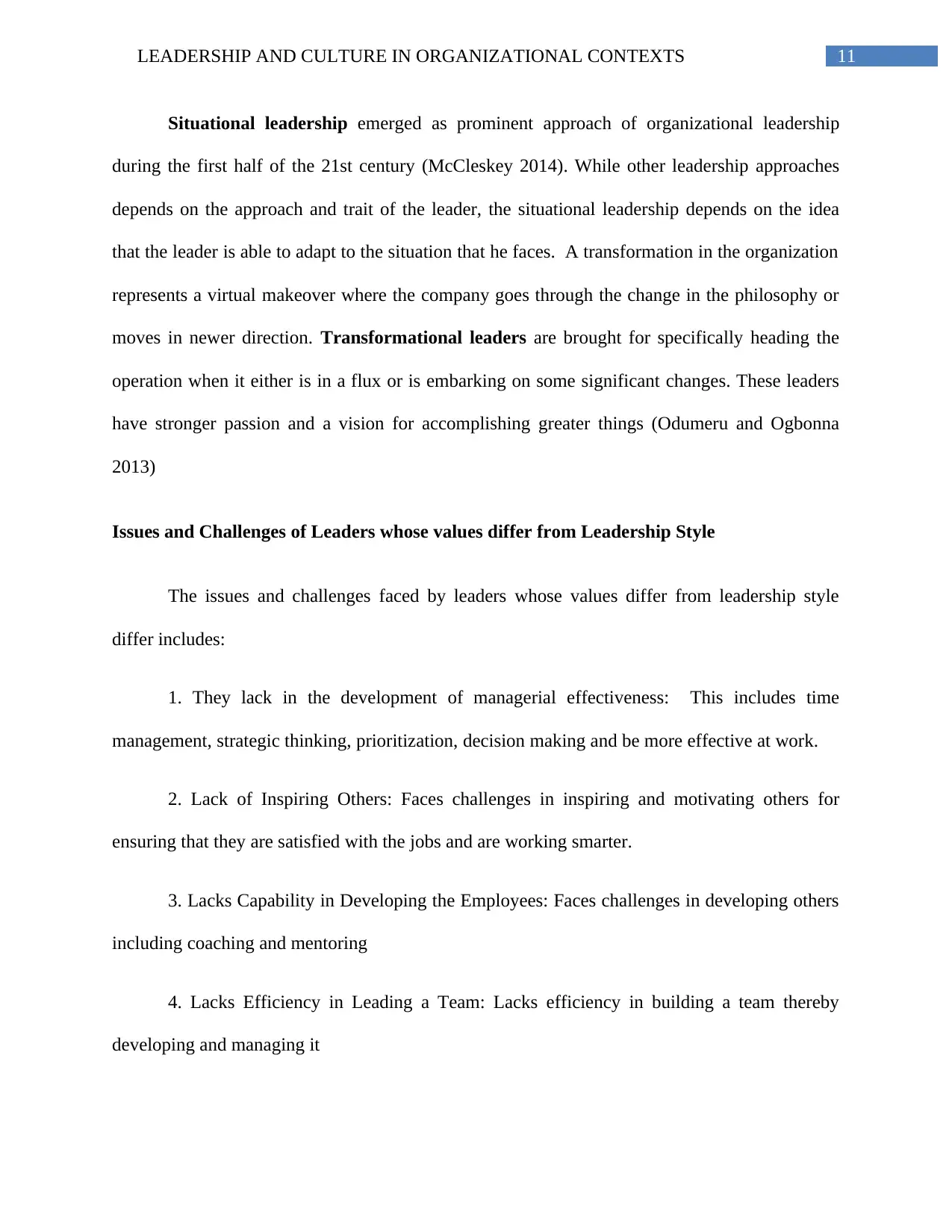
11LEADERSHIP AND CULTURE IN ORGANIZATIONAL CONTEXTS
Situational leadership emerged as prominent approach of organizational leadership
during the first half of the 21st century (McCleskey 2014). While other leadership approaches
depends on the approach and trait of the leader, the situational leadership depends on the idea
that the leader is able to adapt to the situation that he faces. A transformation in the organization
represents a virtual makeover where the company goes through the change in the philosophy or
moves in newer direction. Transformational leaders are brought for specifically heading the
operation when it either is in a flux or is embarking on some significant changes. These leaders
have stronger passion and a vision for accomplishing greater things (Odumeru and Ogbonna
2013)
Issues and Challenges of Leaders whose values differ from Leadership Style
The issues and challenges faced by leaders whose values differ from leadership style
differ includes:
1. They lack in the development of managerial effectiveness: This includes time
management, strategic thinking, prioritization, decision making and be more effective at work.
2. Lack of Inspiring Others: Faces challenges in inspiring and motivating others for
ensuring that they are satisfied with the jobs and are working smarter.
3. Lacks Capability in Developing the Employees: Faces challenges in developing others
including coaching and mentoring
4. Lacks Efficiency in Leading a Team: Lacks efficiency in building a team thereby
developing and managing it
Situational leadership emerged as prominent approach of organizational leadership
during the first half of the 21st century (McCleskey 2014). While other leadership approaches
depends on the approach and trait of the leader, the situational leadership depends on the idea
that the leader is able to adapt to the situation that he faces. A transformation in the organization
represents a virtual makeover where the company goes through the change in the philosophy or
moves in newer direction. Transformational leaders are brought for specifically heading the
operation when it either is in a flux or is embarking on some significant changes. These leaders
have stronger passion and a vision for accomplishing greater things (Odumeru and Ogbonna
2013)
Issues and Challenges of Leaders whose values differ from Leadership Style
The issues and challenges faced by leaders whose values differ from leadership style
differ includes:
1. They lack in the development of managerial effectiveness: This includes time
management, strategic thinking, prioritization, decision making and be more effective at work.
2. Lack of Inspiring Others: Faces challenges in inspiring and motivating others for
ensuring that they are satisfied with the jobs and are working smarter.
3. Lacks Capability in Developing the Employees: Faces challenges in developing others
including coaching and mentoring
4. Lacks Efficiency in Leading a Team: Lacks efficiency in building a team thereby
developing and managing it
⊘ This is a preview!⊘
Do you want full access?
Subscribe today to unlock all pages.

Trusted by 1+ million students worldwide
1 out of 20
Related Documents
Your All-in-One AI-Powered Toolkit for Academic Success.
+13062052269
info@desklib.com
Available 24*7 on WhatsApp / Email
![[object Object]](/_next/static/media/star-bottom.7253800d.svg)
Unlock your academic potential
Copyright © 2020–2025 A2Z Services. All Rights Reserved. Developed and managed by ZUCOL.





